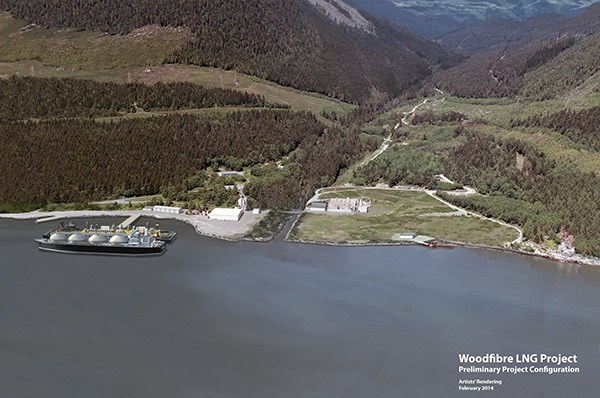Odds are getting longer on picking a winner in B.C.’s liquefied natural gas (LNG) sweepstakes; according to analysts, those same odds apply to getting the province’s LNG sector out of the starting gate at all.
Last week’s throne speech did little to dispel doubts on that front, and that bodes ill for the province because the race to develop B.C.’s LNG sector has a lot riding on it.
Its purse remains in the hundreds of billions of dollars, and project proponents are wagering multi-billions in the quest for that prize.
One of the biggest LNG players is Christy Clark.
Her BC Liberal government originally had it pencilled in for a $100 billion prosperity fund and is selling it to the masses as the key to eliminating B.C.’s provincial debt, which is on track to hit $68.3 billion by 2016-17.
But even Clark is now hedging her bets on the prospects for LNG in B.C., conceding in the October 6 throne speech that the market in the U.S. is gone and not coming back.
That leaves B.C. betting pretty much exclusively on Asia as customer No. 1.
And LNG, according to the throne speech, now provides the province with merely “an opportunity to increase revenue and maintain the same world-class services we rely on.”
The global energy market will ultimately determine the winner.
For those keeping score, the LNG handicapping sheet needs continual updating as new players enter the field, proposals are redrafted and ownership stakes change hands.
As it stands now, there are a trio of front-runners. The rest of the field: long shots at best.
Course conditions
Regardless of which proposal investors, project proponents, the government or anyone else is betting on, obstacles to reaching the marketplace are significant.
They range from access to infrastructure, the domestic and offshore price of natural gas, global competition and consistency of supply to long-term customer contracts and the provincial government’s LNG taxation regime.
Price, of course, will be key.
Unless a proponent is aligned with deep-pocketed investors or those that have priorities that go beyond dollars and cents, it won’t get past that fundamental obstacle.
As geoscientist David Hughes points out, the margins on liquefied natural gas projects in B.C. are already extremely thin.
Those margins, he said, will largely evaporate if there’s any significant rise in the North American domestic price of natural gas and no increase in the price paid for B.C. LNG in Asia or elsewhere.
So for B.C. LNG projects to pay off, “you really have to believe that gas is going to be cheap forever,” said Hughes, president of Global Sustainability Research Inc. and a former geologist with the Geological Survey of Canada.
Mark Jaccard, a professor in the Energy and Materials Research Group at Simon Fraser University, added that the gap between North American prices for natural gas and prices for LNG in Asia won’t last, and as that gap shrinks so too does the B.C. LNG industry’s economic viability.
“Unless British Columbia can out-compete a heck of a lot of other options for East Asia, we won’t build a single LNG plant – unless we get government to subsidize it a lot.”
Well financed
Fracking, which has been revolutionized by horizontal drilling techniques to unlock huge reserves of natural gas from shale rock formations all over North America and elsewhere, has driven down the domestic price for natural gas.
But Hughes pointed out that fracked gas resources are exhausted faster than those from traditional sources because gas released from shale rock formations escapes far quicker.
Hughes said his current review of major shale gas developments in the U.S. shows that the resources in a fracked natural gas well typically drop between 80% and 85% after three years.
So new wells have to be constantly drilled to maintain supply for LNG customers.
At Hughes’ estimated per-well rate of $10 million, that can get expensive.
His B.C. LNG – A Reality Check paper released earlier this year estimated that meeting the National Energy Board export approvals for B.C. LNG projects would require drilling nearly 50,000 new wells in the next 27 years.
That’s double the approximately 25,000 drilled in the province since the 1950s.
Gas guzzlers
Getting natural gas to market in the form of LNG is also extremely expensive.
For example, Hughes said it would take roughly 15% of a producer’s natural gas to generate the energy needed to liquefy it if gas is used to power an LNG plant.
More natural gas is also used for fuel aboard the specialized ocean-bound tankers transporting LNG to Asia and Europe.
In total, Hughes estimated that between 20% and 22% of the gas “is consumed from where you produce it to where you deliver it.”
And as independent energy analyst, and author of Cold, Hungry and in the Dark, Bill Powers pointed out, natural gas resources like those in B.C.’s Horn River basin are in extremely remote areas, which again adds to development costs.
Market challenges
Other major obstacles for all of the LNG proponents include land access and aboriginal land-use issues and competition from countries such as the United States, which is poised to overtake Saudi Arabia as the world’s largest producer of liquid petroleum; Australia, which will be the Asia-Pacific region’s largest LNG supplier once all its new projects are producing by 2017; and Qatar, the world’s largest LNG exporter.
Timing of entry to market and access to infrastructure, an area where the U.S. Gulf Coast state projects have a distinct advantage, are also key challenges for B.C.
The University of Calgary’s Risky Business: The Issue of Timing, Entry and Performance in the Asia-Pacific LNG Market points out that early to market is critical because long-term contracts are fundamental to the economic viability of any LNG project, and once market share is secured, it could take decades for it to become available again.
But in B.C. getting most major resource projects to market at all, let alone early, is difficult.
As Jaccard opined: “I think the chance is getting small that [B.C.] will even develop an LNG industry.”
Energy opportunities
Obstacles in B.C.’s LNG sweepstakes are many, but so are its opportunities and the imperatives to market B.C.’s natural gas resource, which is estimated at more than 500 trillion cubic metres.
Global demand for LNG is projected to rise significantly.
A fall 2014 LNG outlook report from investment bank Peters & Co. estimates it will increase to 275 million metric tonnes per annum (mtpa) by 2015 from 240 mtpa in 2013 and to 500 mtpa by 2030.
Meanwhile, an HSBC forecast released in September predicts that Canada’s 2014-16 energy exports will grow 7.4% to the U.S., which currently receives 97% of Canada’s energy exports, but 53.7% to China during the same period.
As the Business Council of BC (BCBC) pointed out in its LNG Opportunity in BC: Separating Rhetoric from Reality, the province has much in its favour in developing an economically viable and environmentally responsible LNG industry.
Those factors include world-class reserves, decades of experience in the unconventional natural gas sector, political stability and relative proximity to Asian markets, which represented 72% of global natural gas import volumes in 2013.
B.C. LNG best bets
So are any proponents in the B.C. LNG market up to the task?
Analysts see one, maybe two projects in B.C. from three front-runners reaching market by 2025.
According to the Peters & Co. report, the odds-on favourites would be Pacific NorthWest LNG (Petronas) and LNG Canada (Shell).
Pointing to its significant investment in pipelines and the fact that its partners are its LNG customers, Powers would likewise put his money on the Petronas-led plan.
Hughes adds to that Kitimat LNG, “which is probably the most advanced. I wouldn’t give most of the rest of them much of a chance.”
He said projects like Pacific NorthWest, in which national governments are involved, are far more likely to get to market because “they are not as much concerned about price; they are concerned about security of supply.”
He discounted the Vancouver Island-based proposals in large part because of the challenges aligned against securing any approval for building a pipeline from the mainland to Vancouver Island, “which is a hornet’s nest of environmentalists.”
But while the challenges for any of the 16 West Coast projects are significant, Greg Kist, president of Pacific NorthWest LNG, said there are numerous reasons for optimism for B.C.’s LNG industry, including a massive supply of what Kist called “sweet natural gas” that is low in carbon.
In his company’s case, he added customer demand.
“The parties that are in need of this LNG are partners now in our project. … Whether it be Japex out of Japan, Sinopec out of China or Indian Oil Corp., these are all users of the LNG, so you have supply and you have the market tied up.”
As to B.C.’s LNG tax, which no other LNG exporting region has levied and which came under fire in September from Petronas chief executive Shamsul Abbas, Kist said it’s one of a number of economic factors in an overall “fiscal basket” that the company has to consider in deciding whether the project will be viable.
He declined to say whether it could be a game-breaker.
“I wouldn’t pick on any one thing in particular; it really comes down to the entire fiscal basket.”
The province needs at least one B.C. LNG derby winner, because as the BCBC has pointed out, “if we fail to diversify our natural gas markets into Asia via LNG, we are likely to see a material erosion of economic activity in the northeast and northwest for an extended period of time – with corresponding negative impacts on B.C.’s exports, jobs and government revenues.”
Or as the Liberal government’s throne speech warned: the province has a choice between expanding markets in Asia “to maintain and create more jobs here at home, or face decline.”




